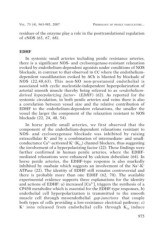Page 165 - 73_04
P. 165
VOL. 73 (4), 963-985, 2007 PHISIOLOGY OF PENILE VASCULATURE...
residues of the enzyme play a role in the posttranslational regulation
of eNOS (63, 67, 68).
EDHF
In systemic small arteries including penile resistance arteries,
there is a significant NOS- and cyclooxygenase-resistant relaxation
evoked by endothelium-dependent agonists under conditions of NOS
blockade, in contrast to that observed in CC where the endothelium-
dependent vasodilatation evoked by ACh is blunted by blockade of
NOS (22,48,63). This non-NO non-prostanoid endothelial is
associated with cyclic nucleotide-independent hyperpolarization of
arterial smooth muscle thereby being referred to as «endothelium-
derived hyperpolarizing factor» (EDHF) (62). As reported for the
systemic circulation, in both penile arteries and veins there is also
a correlation between vessel size and the relative contribution of
EDHF to the endothelium-dependent relaxations, the smaller the
vessel the larger the component of the relaxation resistant to NOS
blockade (22, 24, 48, 54).
In horse penile small arteries, we first observed that the
component of the endothelium-dependent relaxations resistant to
NOS- and cyclooxygenase blockade was inhibited by raising
extracellular K+ and by a combination of intermediate- and small-
conductance Ca2+-activated K+ (KCa) channel blockers, thus suggesting
the involvement of a hyperpolarizing factor (22). These findings were
further confirmed in human penile arteries, where the EDHF-
mediated relaxations were enhanced by calcium dobesilate (64). In
horse penile arteries, the EDHF-type response is also markedly
inhibited by ouabain which suggests an involvement of the Na+-K+
ATPase (22). The identity of EDHF still remains controversial and
there is probably more than one EDHF (62, 70). The available
experimental evidence supports three explanations for the identity
and actions of EDHF: a) increased [Ca2+]i triggers the synthesis of a
CP450 metabolite which is essential for the EDHF-type responses, b)
endothelial cell hyperpolarization is transmitted to the smooth
muscle cell through myoendothelial gap-junctions that couple
both types of cells providing a low-resistance electrical pathway; c)
K+ ions released from endothelial cells through KCa induce
975

